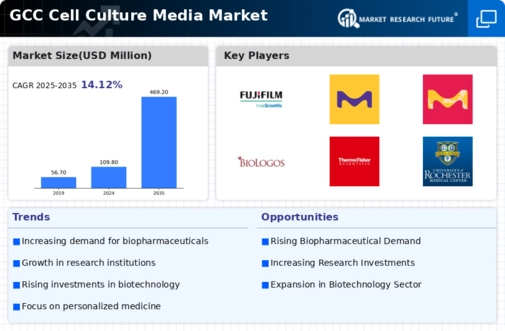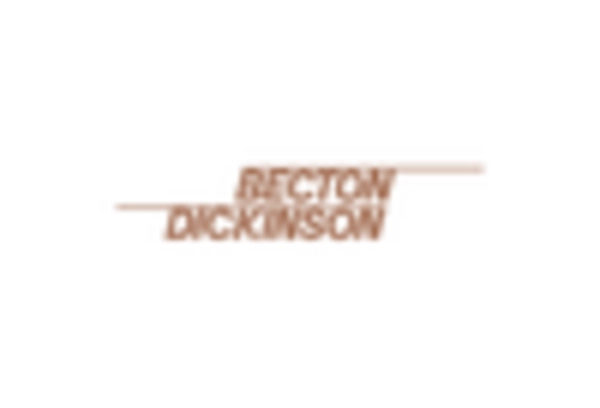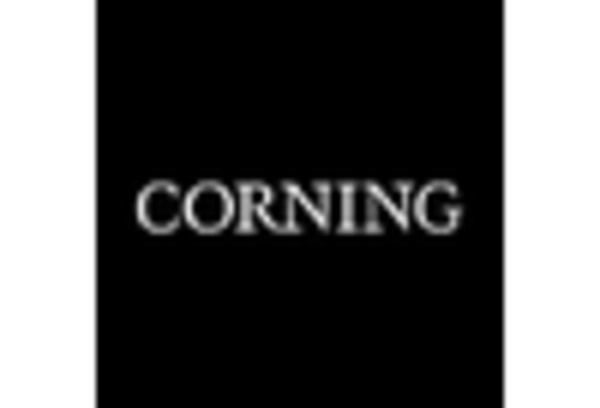Growing Focus on Stem Cell Research
The cell culture-media market is being propelled by the growing emphasis on stem cell research within the GCC region. Stem cell therapies hold immense potential for treating various diseases, and the demand for effective culture media to support stem cell growth and differentiation is increasing. Research institutions and biotech companies are investing in developing specialized media that can enhance stem cell viability and functionality. The stem cell market is projected to grow at a CAGR of approximately 10% from 2025 to 2030, indicating a robust demand for cell culture products tailored for this application. This trend suggests that the cell culture-media market will likely expand as researchers seek to optimize their protocols and improve outcomes in stem cell applications.
Rising Demand for Biopharmaceuticals
The cell culture-media market is experiencing a notable surge in demand driven by the increasing production of biopharmaceuticals. As the GCC region invests heavily in biotechnology, the need for high-quality cell culture media becomes paramount. The biopharmaceutical sector is projected to grow at a CAGR of approximately 8% from 2025 to 2030, indicating a robust market for cell culture products. This growth is largely attributed to the rising prevalence of chronic diseases and the subsequent need for innovative therapies. Consequently, manufacturers are focusing on developing specialized media formulations that cater to the unique requirements of biopharmaceutical production, thereby enhancing the overall efficiency and yield of cell cultures. The expansion of this sector is likely to propel the cell culture-media market forward, creating opportunities for both established and emerging players in the industry.
Regulatory Support for Biotechnology Initiatives
Regulatory frameworks in the GCC are evolving to support the growth of the biotechnology sector, which in turn impacts the cell culture-media market. Governments are implementing policies that encourage research and development in biopharmaceuticals and regenerative medicine. For instance, initiatives aimed at streamlining the approval processes for new therapies are likely to enhance the demand for cell culture media. The GCC region is witnessing an increase in funding for biotech startups, with investments reaching approximately $500 million in 2025 alone. This financial backing is expected to foster innovation in cell culture technologies, thereby driving the need for specialized media that meet regulatory standards. As a result, the cell culture-media market is poised for growth, benefiting from a supportive regulatory environment.
Increased Collaboration Among Research Institutions
Collaboration between research institutions and industry players is becoming increasingly prevalent in the GCC, significantly impacting the cell culture-media market. Such partnerships facilitate the sharing of knowledge and resources, leading to the development of innovative cell culture media solutions. Collaborative projects often focus on addressing specific challenges in cell culture, such as optimizing media formulations for various cell types. The rise in joint ventures and research consortia is expected to enhance the quality and availability of cell culture products. As these collaborations grow, the cell culture-media market is likely to benefit from a more diverse range of offerings, catering to the evolving needs of researchers and biopharmaceutical companies in the region.
Technological Advancements in Cell Culture Techniques
Technological innovations are significantly influencing the cell culture-media market, particularly in the GCC region. The advent of advanced cell culture techniques, such as 3D cell culture and organ-on-a-chip technologies, is reshaping the landscape of biological research and drug development. These methods require specialized media that can support complex cellular environments, thus driving demand for innovative formulations. The market for 3D cell culture is expected to grow at a CAGR of around 15% over the next five years, suggesting a shift towards more sophisticated cell culture methodologies. As researchers and companies adopt these technologies, the need for tailored media solutions will likely increase, presenting a substantial opportunity for growth within the cell culture-media market.

















Leave a Comment